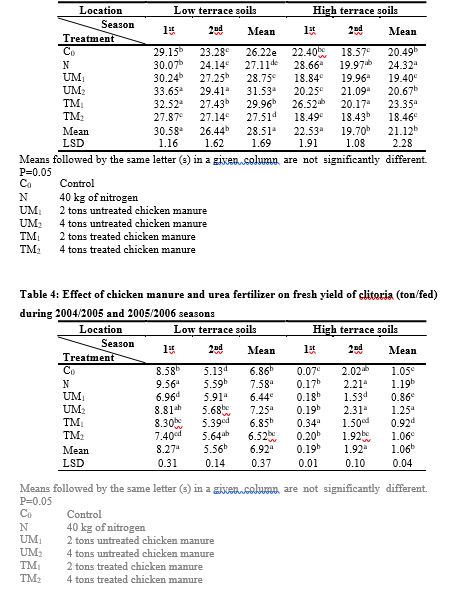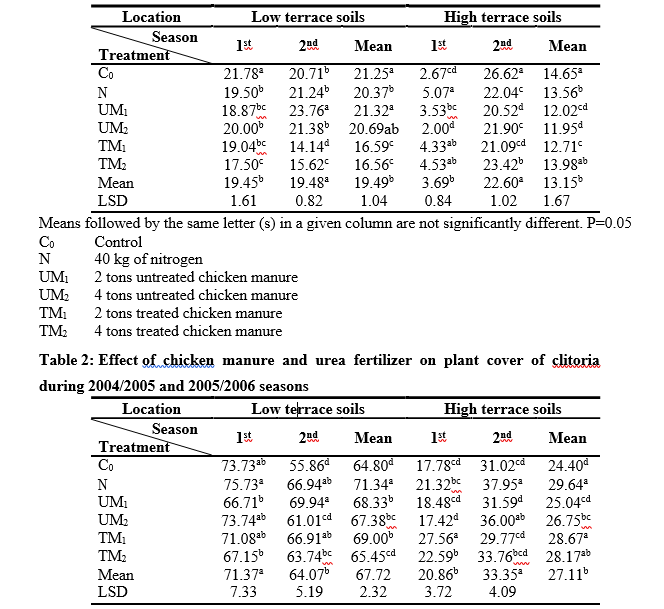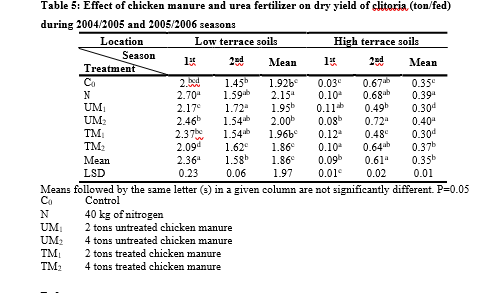
Research paper
Effect of Chicken Manure and Urea Fertilizer on Growth and Yield of Clitoria (Clitoria ternatea) under Two Types of Soils
Abdelnasir Awad Abdalla1 and Awad Osman Abusuwar2
- Depart of Seed Technology, Faculty of Agriculture, Nile Valley University, Dar mali, Sudan
- Department of Arid Land Agriculture, Faculty of Meteorology, Environment and Arid Land Agriculture, King Abdal Aziz University, Saudi Arabia
Corresponding author: عنوان البريد الإلكتروني هذا محمي من روبوتات السبام. يجب عليك تفعيل الجافاسكربت لرؤيته.
A B S T R A C T
Effect of Chicken Manure and Urea Fertilizer on Growth and Yield of clitoria
تأثير سماد مخلفات الدواجن واليوريا على النمو والإنتاجية لمحصول الكلايتوريا المزروعة
في نوعين من الأراضي
عبد الناصر عوض عبد الله 1وعوض عثمان أبو سوار2
1قسم تكنولوجيا البذور، كلية الزراعة - جامعة وادي النيل – السودان
2قسم الاراضي القاحلة – جامعة الملك عبد العزيز- المملكة العربية السعودية
أجريت تجربتين حقليتين خلال المواسم 5/2004و 6/2005بمزرعة كلية الزراعة جامعة وادي النيل بدارمالي لدراسة تأثير
المستويات المختلفة من سماد الدواجن المخمر وغير المخمر ( 2،4طن/فدان) وسماد اليوريا (صفر،50كجم يوريا/فدان) على
النمو والإنتاجية للكلايتوريا المزروعة في أراضي الجروف والتروس العليا. استخدم تصميم القطع المنشقة بثلاث مكررات.
أدت إضافة سماد الدواجن المخمر وغير المخمر إلى زيادة معنوية في الغطاء النباتي والمساحة الورقية للكلايتوريا. وأعطى
أعلى معدل لسماد الدواجن (4طن /فدان) زيادة معنوية للوزن الرطب والوزن الجاف. سماد الدواجن غير المخمر أدى إلى زيادة
الوزن الرطب والوزن الجاف بنسبة %76.7و %12على التوالي مقارنة بسماد الدواجن المخمر. إضافة السماد النيتروجيني
أدت إلى زيادة معنوية في الكثافة النباتية والوزن الجاف. فيما يتعلق بالمواقع أظهرت الكلايتوريا المزروعة في الجروف أعلى
إنتاجية مقارنة بالتروس العليا
Abdelnasir A. A. and Awad O. A. / Nile Journal for Agricultural Sciences Vol. 2, NO. 1 (2017) 64 - 73
Introduction
In Sudan, clitoria is grown mainly under irrigation in area of about (105.000 feddans) mainly in Khartoum, Gezira, White Nile, and Blue Nile State. It is also grown under rainfed conditions in few pockets in former Southern Sudan (Abusuwar and Abdella, 2001). Burhan and Makki (1989) found that if clitoria is established by irrigation, the plant remain alive till the following rains. Expansion in the cultivated areas in Sudan and the extension to marginal lands away from fertile soil closer to the river banks has enhanced attempts to make use of these marginal lands by cultivating tolerant crops of low fertilizer and water demands or by reclamation of these soils by different available methods Eltilib et al (1993).
Organic agriculture is currently gaining increasing popularity as alternative strategy to chemical fertilization and receives more attention world-wide (Mahadi,1993). Manure supplies nutrients required by plants and improves the physical properties of the soil (Elhassan,1993). Chicken manure is one of the most promising sources of nitrogen and organic matter. Besides, it could be useful as soil amendment.
In the present work, response of clitoria to chicken manure and chemical nitrogen (urea) under the low and high terrace soils was studied.
Materials and methods
The study was carried out during the period 2004 to 2006 at the farms of the faculty of agriculture, Nile valley University in Darmali, River Nile state (latitude 17º 48- N, longitude 34 º 00- E and 346.5m above sea level). The soil of the low terraces is silt clay (clay 42.12, pH 7.6, organic carbon 26%, organic nitrogen 344 ppm and ESP 4.8. The high terrace soils are sandy clay loam, saline (sand 56.19 %, clay 26.26 %, silt 19. 37 %, pH 8.8, organic carbon 0.67 %, organic nitrogen 178 ppm and ESP 31.8).
The treatments consisted of two levels of treated and untreated chicken manure (2 and 4tons/feddan) and tow levels of urea (46 % nitrogen) 0 and 50 kg/feddan. The treatments were arranged in split plot design and replicated three times. For treated chicken manure a pit was made in the soil. Chicken manure was moistened with water, covered with plastic sheet and then a layer of soil was spread on top and left three weeks for fermentation. The treated and untreated chicken manure were applied before sowing, broadcasted manually on the bottom of the ridge, mixed with soil and distributed equally to the whole plot using a rake. Nitrogen fertilizer was drilled on one side of ridge in the form of urea after two weeks from planting. Sowing was done on the 15th of July at the rate of 10 kg/feddan, for the low and high terrace soils.
Effect of Chicken Manure and Urea Fertilizer on Growth and Yield of clitoria
The growth parameters, which were measured during the course of the study included the plant density, leaf area, plant cover, fresh yield and dry yield. Plant density was determined by counting the number of plants in an area of 0.7m2 for each plot. Leaf area was determined each time at harvest. Five plants were randomly taken from each plot, leaves were punctured and oven direct at 80ºc for 48 hrs. Leaf area was calculated using the following formula (Watson and Watson, 1953):
Wt. of leaf × area of discs
Leaf area =
Wt. of leaf discs
Percent cover was estimated by a rectangular quadrat of 50×50 cm2.The quadrat was randomly thrown in each plot and plants within the area of the quadrat were estimated as a percent in relation to the area of quadrat. The cover estimation values were converted using the Arc-Sin transformation methods before analysis of the data. For fresh yield determination the whole plot was harvested and fresh weight was measured immediately in the field using a spring balance. Plants were harvested for forage determination when they obtained full canopy or at early flowering, whichever came first. Forage dry yield was determined each time at harvest by using a sample of o.7 m2 from the middle of the plot, and oven dried at 702c for 48 hours until a constant weight was reached.
Results and discussion
The control treatment was significantly higher in plant density of clitoria in the first and second season of the low and high terrace soils respectively, while the effect of chicken manure resulted during the second season of the low terrace soils (Table 1). Phytotoxic substance from the manure might cause the damage of seeds in the first season of the low terrace and second season of the high terrace soils. Similar results were mentioned by Robertson and Morgan (1995). Moreover, the gradual release of nutrients from the manure in the second season of the high terrace soils might have benefited the crops.
As shown in Table (1), number of plants/m2 of clitoria were significantly higher in the low terrace soils compared to the high terrace soils. High concentration of salt in the high terrace soils might resulted in high osmotic pressure of the soil solution that lowered water imbibitions by seed coat and plant to inhibit the hydrolytic processes that yield energy necessary for emergence of the shoot and of the seedlings establishment. The result obtained is in line with that reported by Aceres et al. (1975).
Addition of nitrogen significantly increased plant cover of clitoria in the first season of the low terrace soils and in the second season of the high terrace soils (Table 2). Untreated chicken manure (UM1) significantly increased plant cover in the second season of the low terrace soils,
Abdelnasir A. A. and Awad O. A. / Nile Journal for Agricultural Sciences Vol. 2, NO. 1 (2017) 64 - 73
while treated chicken manure (TM1) significantly increased it in the first season of the high terrace soils. Since increasing the supply of nitrogen almost always increase the shoot/root ratio and the root growth also increases, plant cover increase. This finding is in agreement with that of Abusuwar and Elzilal (2006) and Ellnhamm (1995). Plant cover was high in the low terrace soils compared to the high terrace soils. However, plant cover in the low terrace soils was higher in the first season than the second season and the opposite was true in the high terrace soils. This may be attributed to the favorable conditions such as soil fertility and higher ability of the soil for moisture retention. This result confirms the findings of Ashraf and Menilly (1987).
As shown in Table (3), the highest rate of untreated chicken manure (UM1) significantly increased leaf area of clitoria in both seasons of the low terrace soils and during the second season of the high terrace soils. This might be attributed to the improvement of the soil condition and the restoration of the soil fertility that result in vigorous growth and healthy plants. This result seems to be in agreement with the finding of Ibrahim (1996) and Abusuwar and Elzilal (2006).
Leaf area was higher in the low terrace soils compared to the high terrace soils due to the favorable growing conditions manifested by relatively good physical and chemical properties of low terrace soils. The highest rate of untreated chicken manure (UM1) significantly increased forage fresh yield of clitoria in the low and high terrace soils. Application of nitrogen fertilizer significantly increased fresh yield in the first season of the low terrace soils. Warm, moist conditions favorable for microbial decomposition of chicken manure in the second season to release nitrogen from manure might be the reason. This result is in line with that reported by Mohamed (1990) who found that nitrogen fertilizer increased the yield and growth attributes of grasses and legumes during the first season. Similar results for the effect of higher rate of chicken manure were reported by Abusuwar and Elzilal (2006), Ellnham (1995) and Hassan (2002).
Fresh yield of Clitoria was significantly higher in the low terrace soils compared to the high terrace soils. In the first season of the low terrace soils fresh yield was significantly higher than the second season, while the opposite in the high terrace soils (Table 4). This may be due to the favorable conditions such as moisture and soil fertility in the low terrace soils. This result is in line with those reported by Osman and Abu-Diek (1982).
Application of nitrogen fertilizer significantly increased dry yield of clitoria in the low terrace soils, while the higher rate of untreated chicken manure (UM1) significantly increased dry yield of clitoria in the high terrace soils (Table 5). This may be due to its higher nitrogen content, organic carbon, cation exchange improved soil structure and water relations. This result is in line with those reported by Mondini et al. (1993) and Hansen (1996). Dry yield of clitoria was higher in the low
Effect of Chicken Manure and Urea Fertilizer on Growth and Yield of clitoria
terrace soils compared to the high terrace soils. This may be due to the fertile soil and higher moisture content.
Table 1: Effect of chicken manure and urea fertilizer on plant density/m2 of clitoria during 2004/2005 and 2005/2006 seasons.
Abdelnasir A. A. and Awad O. A. / Nile Journal for Agricultural Sciences Vol. 2, NO. 1 (2017) 64 - 73
Table 3: Effect of chicken manure and urea fertilizer on leaf area (cm2) of clitoria during 2004/2005 and 2005/2006 seasons.

Effect of Chicken Manure and Urea Fertilizer on Growth and Yield of clitoria
Table 5: Effect of chicken manure and urea fertilizer on dry yield of clitoria (ton/fed) during 2004/2005 and 2005/2006 seasons
References
Abusuwar, A.O. and Abdalla, A.A. (2001). Effect of phosphorus fertilizer and type of seedbed on growth, dry yield and seed yield of clitoria (Clitoria ternatea). University of Khartoum J.of Agric.Sci.9 (1), 29 –45.
Abusuwar, A.O. and Elzilal, H.A. (2006). Effect of chicken manure on the performance of two forage sorghum cultivars in Khartoum State. University of khartoum J. of Agric. Sci. 14(2), 227 – 236.
Aceres, N.E.; Stalzy, L.H. and Mechuys, G.R. (1975). Effect of soil osmotic potential produced with two salt species on plant water potential, growth and grain yield of wheat. Plant and Soil. 42: 619 – 628.
Ashraf, M. and Menilly, T. (1987). Salinity effect on five cultivars of pearl millet (Pennisetum americanum). Plant and Soil. 103: 13 – 19.
Burhan, H.O. and Makki, Y.M. (1989). Agronomic and nutritional evaluation of some selected forage crops grown in Al- HASSA. Bulletin 23 – 24.
Abdelnasir A. A. and Awad O. A. / Nile Journal for Agricultural Sciences Vol. 2, NO. 1 (2017) 64 - 73
Elhassan, M.M. (1993). Effect of farmyard manure on soil fertility, mmicrobial activity and Wheat Grain yield. M.Sc. Thesis Faculty of Agriculture, University of Gezira, Wad Medani Sudan..
Ellnham, M.M. (1995). Yield and Quality of Forage Sorghum (Sorghum bicolor) Cultivar Abu Sabein as affected by Nitrogen, Poultry Manure and Cow Manure. M.Sc. Thesis, University of Gizera, Wad Medani, Sudan.
Eltilib, A.M.A.; Ali, A.M. and Abdalla, M.A. (1993). Effect of chicken manure and salinity on growth and leaf N, P and K contents of okra growth on two soil types. Journal of Agric. Sci. Vol.(2), 16 – 35.
Hansen, S. (1996). Effect of manure treatment and soil compaction on plant production of a dairy farm system converting to organic farming practice. Agriculture, Ecosystem and Environment (56) 173 – 186.
Hassan, H.A.E. (2002). Effect of Chicken manure and season on the performance and HCN content of two Forage Sorghum Cultivars. Ph.D. Thesis, Faculty of Agriculture, University of Khartoum Sudan.
Ibrahim, A.S. (1996). Growth and forage yield of pearl millet (Pennisetum americanum L.) as affected by irrigation frequency, seed rate and nitrogen in the United Arab Emirates. University of Khartoum J. of Agric. Sci. Vol. (4) No. 1.
Mahadi, A.A. (1993). Biofertilizer research in Sudan. Areview, University of Khartoum Journal of Agric. Sci. 1 (1): 137 – 153.
Mohamed, G.G. (1990). The effect of nitrogen and phosphorus fertilizers on growth and yield of some grasses and leguminous forages. Sudan Science Abstract Vol. (18).
Mondini, C.; Chiumenti, R.; Da Borso, F.; Leita, L. and De Nobili, M. (1996). Changes during processing in the organic matter of composted and air dried poultry manure, Bioresource Technology 55: 243 – 249.
Osman, A.E. and Abu-Diek, A.A. (1982). Effect of defoliation on yield and forage quality of some tropical grasses, legumes and their mixtures. J. Exp. Agric. 18: 157-166.
Robertson, F.A. and Morgan, W.C. (1995). Mineralization of C and N in organic materials as affected by duration of composting. Aust. J. Soil Res. 33: 511-514.
Watson, D.J. and Watson, M.A. (1953). Comparative physiological studies on growth of field crops. Ann. Appl. Biol. 40: 1-6.
Effect of Chicken Manure and Urea Fertilizer on Growth and Yield of clitoria





